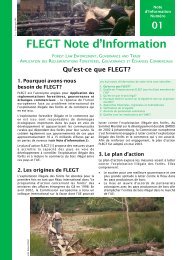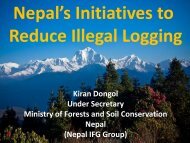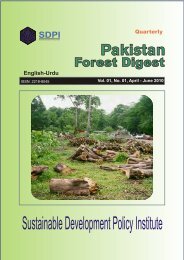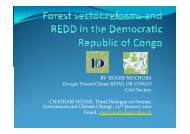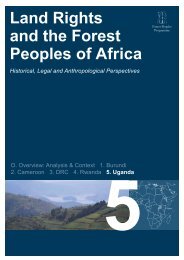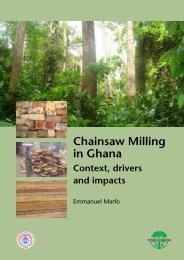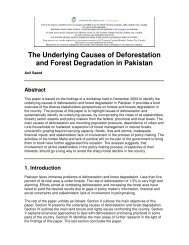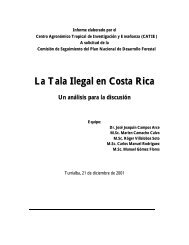conflict over natural resources at the community level in nepal
conflict over natural resources at the community level in nepal
conflict over natural resources at the community level in nepal
You also want an ePaper? Increase the reach of your titles
YUMPU automatically turns print PDFs into web optimized ePapers that Google loves.
Case Study 2: Conflict between a Hydropower Project and Developer and Affected CommunitiesHydropower Project: Middle Marshyangdi Hydropower Project, Lamjung, NepalDistrict: LamjungVillages: Sundarbazar, Bhoteodar, Udipur, Chiti and GaonshaharNepal is endowed with a vast potential for hydropower. It has a <strong>the</strong>oretical potential of 83,000 megaw<strong>at</strong>ts anda technically and economically feasible capacity of 42,000 megaw<strong>at</strong>ts. Contrary to its potential, Nepal’sdeveloped capacity is only about 600 megaw<strong>at</strong>ts. There have been several <strong>in</strong>iti<strong>at</strong>ives taken by <strong>the</strong> g<strong>over</strong>nmentto harness hydropower by <strong>in</strong>vit<strong>in</strong>g <strong>the</strong> n<strong>at</strong>ional and <strong>in</strong>tern<strong>at</strong>ional priv<strong>at</strong>e <strong>in</strong>vestors as well as <strong>in</strong>volv<strong>in</strong>g <strong>the</strong>g<strong>over</strong>nment subsidiary (s<strong>in</strong>ce 1990). The g<strong>over</strong>nment has made policy arrangements not only to providespace for <strong>the</strong> <strong>in</strong>vestors but also to properly manage <strong>the</strong> local environment. The Environmental ProtectionAct and subsequent regul<strong>at</strong>ions have been <strong>in</strong>troduced to carry out Environmental Impact Assessmentsthrough which <strong>the</strong> local environmental and social issues could be addressed. There have been provisions tocarry out public consult<strong>at</strong>ions and hear<strong>in</strong>gs <strong>in</strong> order to capture and address issues of <strong>the</strong> local communitieswhere <strong>the</strong> hydropower project is to be developed.Despite such arrangements and practices, <strong>the</strong>re have been <strong>conflict</strong>s between <strong>the</strong> affected communities and<strong>the</strong> hydropower developer. The local communities claim th<strong>at</strong> <strong>the</strong> power developer ignores <strong>the</strong>ir concerns,whereas <strong>the</strong> power developer claims th<strong>at</strong> <strong>the</strong> local communities expect more and are not cooper<strong>at</strong><strong>in</strong>g. CARENepal, <strong>in</strong> partnership with two local NGOs, has been implement<strong>in</strong>g a g<strong>over</strong>nance program s<strong>in</strong>ce November2002, and <strong>the</strong> program hoped to pilot a w<strong>in</strong>-w<strong>in</strong> partnership between <strong>the</strong> affected communities and <strong>the</strong>power developer.After a year of explor<strong>at</strong>ory activities to review <strong>the</strong> opportunities and constra<strong>in</strong>ts <strong>in</strong> work<strong>in</strong>g with suchcomplex issue, <strong>the</strong> program was <strong>in</strong>troduced <strong>at</strong> <strong>the</strong> field <strong>level</strong> by <strong>the</strong> end of 2003. The program’s <strong>in</strong>terventionswere:• Streng<strong>the</strong>n<strong>in</strong>g <strong>the</strong> <strong>in</strong>ternal g<strong>over</strong>nance practices of <strong>the</strong> local communities by enhanc<strong>in</strong>g transparent andparticip<strong>at</strong>ory process and accountable actions;• Organiz<strong>in</strong>g tra<strong>in</strong><strong>in</strong>gs, workshops and an awareness campaign to share g<strong>over</strong>nment policies and provisionsregard<strong>in</strong>g hydropower development and environmental management to <strong>the</strong> local communities;• Develop<strong>in</strong>g common forums such as coord<strong>in</strong><strong>at</strong>ion committees and workshops, with represent<strong>at</strong>ive from<strong>the</strong> local communities, <strong>the</strong> power developer, and <strong>the</strong> local-<strong>level</strong> g<strong>over</strong>nment l<strong>in</strong>e agencies to discuss <strong>the</strong>issues and concerns; and• Institutionaliz<strong>in</strong>g particip<strong>at</strong>ory monitor<strong>in</strong>g to ensure effective implement<strong>at</strong>ion of <strong>the</strong> environmentalmanagement plan.The <strong>level</strong> of <strong>conflict</strong> has been reduced drastically. Both parties (<strong>the</strong> local communities and <strong>the</strong> powerdeveloper) work toge<strong>the</strong>r with <strong>the</strong> local-<strong>level</strong> g<strong>over</strong>nment agencies to acknowledge <strong>the</strong> problems each faceand settle <strong>the</strong> issues. Their present rel<strong>at</strong>ionship is now face to face. They symbolize <strong>the</strong>ir rel<strong>at</strong>ionship p<strong>at</strong>ternswith <strong>the</strong> Nepali numbers 3 and 6 like this—previous 36 and now 63.24 CONFLICT OVER NATURAL RESOURCES AT THE COMMUNITY LEVEL IN NEPAL





